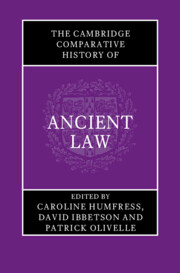17 results

The Cambridge Comparative History of Ancient Law
- Coming soon
-
- Expected online publication date:
- May 2024
- Print publication:
- 31 May 2024
-
- Book
- Export citation
1 - Out of Time? Eternity, Christology, and Justinianic Law
-
-
- Book:
- Time, History, and Political Thought
- Published online:
- 08 June 2023
- Print publication:
- 22 June 2023, pp 36-53
-
- Chapter
- Export citation
Legal Pluralism's Other: Mythologizing Modern Law
-
- Journal:
- Law and History Review , First View
- Published online by Cambridge University Press:
- 09 June 2023, pp. 1-14
-
- Article
-
- You have access
- Open access
- HTML
- Export citation
1 - The Early Church
- from Part I - The History of Medieval Canon Law
-
-
- Book:
- The Cambridge History of Medieval Canon Law
- Published online:
- 13 January 2022
- Print publication:
- 27 January 2022, pp 11-31
-
- Chapter
- Export citation
13 - Entangled Legalities beyond the (Byzantine) State
- from Part IV - Situating Entanglements
-
-
- Book:
- Entangled Legalities Beyond the State
- Published online:
- 29 October 2021
- Print publication:
- 11 November 2021, pp 353-375
-
- Chapter
-
- You have access
- Open access
- HTML
- Export citation
‘Cherchez la femme!’ Heresy and Law in Late Antiquity
-
- Journal:
- Studies in Church History / Volume 56 / June 2020
- Published online by Cambridge University Press:
- 15 May 2020, pp. 36-59
- Print publication:
- June 2020
-
- Article
- Export citation
7 - Patristic Sources
- from Part III - Roman Law: The Evidence
-
-
- Book:
- The Cambridge Companion to Roman Law
- Published online:
- 05 February 2015
- Print publication:
- 16 February 2015, pp 97-118
-
- Chapter
- Export citation
Contributors
-
-
- Book:
- The Cambridge Companion to Roman Law
- Published online:
- 05 February 2015
- Print publication:
- 16 February 2015, pp vii-viii
-
- Chapter
- Export citation
8: - Law and Legal Culture in theAge of Attila
- from Part I - The Roman Empire
-
-
- Book:
- The Cambridge Companion to the Age of Attila
- Published online:
- 05 October 2014
- Print publication:
- 29 September 2014, pp 140-155
-
- Chapter
- Export citation
Contributors
-
-
- Book:
- The Cambridge Companion to the Age of Attila
- Published online:
- 05 October 2014
- Print publication:
- 29 September 2014, pp xiii-xiv
-
- Chapter
- Export citation
Four - Laws’ Empire: Roman Universalism and Legal Practice
-
-
- Book:
- The City in the Classical and Post-Classical World
- Published online:
- 05 April 2014
- Print publication:
- 14 April 2014, pp 81-108
-
- Chapter
- Export citation
List of Contributors
-
-
- Book:
- The City in the Classical and Post-Classical World
- Published online:
- 05 April 2014
- Print publication:
- 14 April 2014, pp xi-xiv
-
- Chapter
- Export citation
Late Antique Egypt - (P.) Sarris Economy and Society in the Age of Justinian. Pp. xii + 258, figs, ill., maps. Cambridge: Cambridge University Press, 2006. Cased, £45, US$80. ISBN: 978-0-521-86543-2.
-
- Journal:
- The Classical Review / Volume 58 / Issue 2 / October 2008
- Published online by Cambridge University Press:
- 02 December 2008, pp. 529-530
- Print publication:
- October 2008
-
- Article
- Export citation
R. Finn, Almsgiving in the Later Roman Empire: Christian Promotion and Practice (313–450). Oxford: Oxford University Press, 2006. Pp. 302. ISBN 0-19- 928360-5. £55.00.
-
- Journal:
- The Journal of Roman Studies / Volume 97 / November 2007
- Published online by Cambridge University Press:
- 08 March 2010, pp. 389-390
- Print publication:
- November 2007
-
- Article
- Export citation
Chapter 11 - Poverty and Roman law
-
-
- Book:
- Poverty in the Roman World
- Published online:
- 22 September 2009
- Print publication:
- 09 October 2006, pp 183-203
-
- Chapter
- Export citation
9 - Civil Law and Social Life
- from Section III - Law and Society
-
-
- Book:
- The Cambridge Companion to the Age of Constantine
- Published online:
- 28 September 2007
- Print publication:
- 14 November 2005, pp 205-225
-
- Chapter
- Export citation
7 - Law and Legal Practice in the Age of Justinian
- from Part 1 - Structures and Ideologies of Empire
-
-
- Book:
- The Cambridge Companion to the Age of Justinian
- Published online:
- 28 May 2006
- Print publication:
- 18 April 2005, pp 161-184
-
- Chapter
- Export citation



